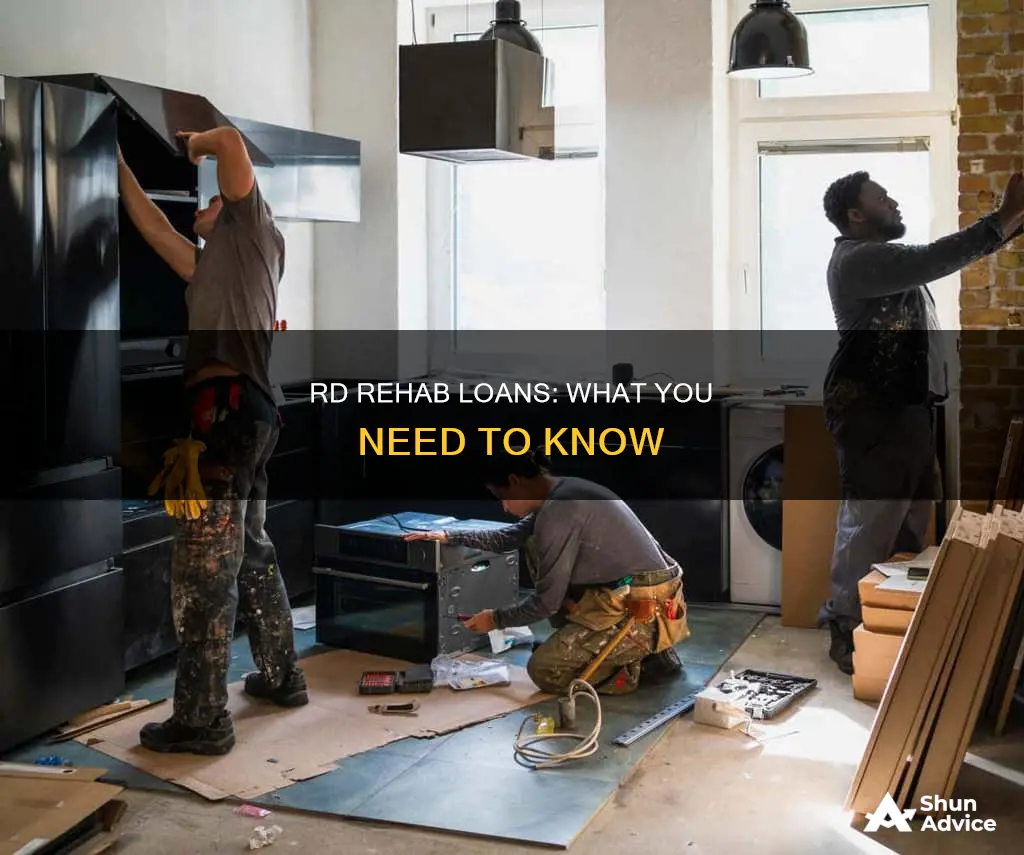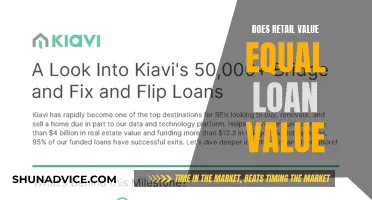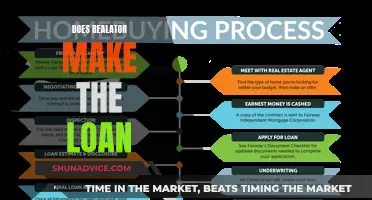
Rehab loans, also known as renovation loans, are a great way for property investors to finance renovations and upgrades on existing homes. They allow borrowers to purchase or refinance a home and make repairs or improvements with one loan. The USDA Rural Development (RD) offers a Single-Family Housing Guaranteed Loan Program to assist low- and moderate-income households in eligible rural areas. Under this program, eligible applicants can purchase, build, rehabilitate, improve, or relocate a dwelling in a rural area. The program provides a 90% loan note guarantee to approved lenders, reducing the risk of extending 100% loans to eligible rural homebuyers. Additionally, the Section 504 Home Repair program offers loans to very-low-income homeowners in rural areas to repair, improve, or modernize their homes. So, yes, RD does offer rehab loans as part of their housing programs to strengthen rural communities.
| Characteristics | Values |
|---|---|
| Loan provider | USDA Rural Development |
| Loan type | Single-Family Housing Guaranteed Loan Program |
| Loan name | Section 502 Guaranteed Loan Program |
| Target group | Low- and moderate-income households |
| Purpose | Purchase, build, rehabilitate, improve or relocate a dwelling |
| Location | Eligible rural areas |
| Down payment | 0% |
| Citizenship | U.S. Citizen, U.S. non-citizen national or Qualified Alien |
| Other programs | Single-Family Housing Direct Loan Program |
What You'll Learn

The Single Family Housing Guaranteed Loan Program
The funds from the program can be used for new or existing residential properties, including detached, attached, condos, PUDs, modular, or manufactured structures. The property must be used as the borrower's primary residence and cannot be an income-producing property. Closing costs and reasonable expenses associated with the purchase can be included in the loan.
The program also allows for repairs and rehabilitation when associated with the purchase of an existing dwelling. Additionally, eligible borrowers may purchase a site with a new or existing dwelling, with no set acreage limits. The loan can also be used for essential household equipment, such as wall-to-wall carpeting, ovens, refrigerators, and heating and cooling equipment, if conveyed with the dwelling. Site preparation costs, such as grading, foundation, seeding, trees, fences, and driveways, are also eligible expenses.
Quebec Loans: Scholarship Revenue or Separate Entity?
You may want to see also

The Single-Family Housing Direct Loan Program
To be eligible for the program, applicants must meet specific income requirements, demonstrating that their income is at or below the applicable low-income limit for the area in which they plan to purchase a home. They must also show a willingness and ability to repay the debt. The program does not require a down payment, and applicants can benefit from a fixed interest rate based on current market rates at loan approval or closing, whichever is lower. The interest rate can be as low as 1% when modified by payment assistance.
The loan funds can be used to help individuals or households purchase, build, repair, renovate, or relocate homes in eligible rural areas. Funds can also be used to purchase and prepare sites, including providing essential household equipment and necessary facilities like water and sewage. The program promotes affordable homeownership, which in turn creates thriving communities and improves the quality of life in rural areas.
It is important to note that the Single-Family Housing Direct Loan Program is just one of several housing programs offered by USDA Rural Development to strengthen rural communities. Applicants are encouraged to explore all their options and consult with their local state RD office to determine the best program for their needs.
Private Loans: Impacting Your Financial Aid Eligibility?
You may want to see also

Rehab loan types
There are several types of rehab loans available to homeowners and buyers. These include:
FHA 203(k) Rehab Loan
This loan is ideal for those buying a "fixer-upper" and who need funding for home improvement projects. The FHA 203(k) rehab loan is backed by the government, meaning borrowers benefit from a low down payment and the ability to apply with a less-than-perfect credit profile. However, this loan can take longer to close. A minimum credit score of 620 is required for this type of loan.
Cash-Out Refinancing
Cash-out refinancing is a good option for those with a newer or higher-value home. A minimum credit score of 620 is required.
Personal Loan
Personal loans are unsecured loans that can be used for almost any purpose. They are best for those who want quick cash to start a project and want to avoid using their home as collateral to secure a loan. Well-qualified borrowers may be able to secure a competitive interest rate of under 8% and repayment terms of up to seven years. A credit score in the low-to-mid 700s is ideal for this type of loan.
Home Equity Loan (HEL)
A home equity loan allows borrowers to borrow against the equity built up in their home. The equity is calculated by assessing the home's value and subtracting the outstanding balance on the existing mortgage loan. A FICO score of 680-700 or higher is required for this type of loan.
Construction Perm Loan (C/P Loan)
A C/P Loan is a bridge between construction financing and a separate "end loan" or permanent financing. It allows borrowers to choose their ideal location, design, and construction. A minimum credit score of 660 for FHA and VA, and 680 for Conventional is required.
Single-Family Housing Guaranteed Loan Program
The USDA's Single-Family Housing Guaranteed Loan Program assists approved lenders in providing low- and moderate-income households the opportunity to own adequate, modest, and safe dwellings as their primary residence in eligible rural areas. Eligible applicants may purchase, build, rehabilitate, improve or relocate a dwelling in an eligible rural area with 100% financing.
Prime Lending: Selling Loans and Mortgage Deals
You may want to see also

The application process
- Prequalification (Optional): Potential applicants can choose to go through an informal prequalification process to determine if the repair program is a good fit. They can contact their local Rural Development office and provide the necessary documentation, including Form RD 3550-35 (Section 504 Home Repair Loan and Grant Program Intake Form) and Form RD 3550-1 (Authorization to Release Information).
- Documentation: Applicants must gather and provide various documents for the loan application. This includes Form RD 410-4 (Uniform Residential Loan Application) and other relevant financial and property-related documents.
- Contact a Lender: Applicants can reach out to one of the approved lenders participating in the Single-Family Housing Guaranteed Loan Program. The approved lender will handle the entire loan application process, working with Rural Development staff to ensure the loan is guaranteed.
- Complete Loan Application: Borrowers fill out a standard loan application, providing detailed information about their finances, planned repairs or renovations, and the property in question.
- Provide Additional Information: Depending on the lender and loan program, applicants may need to provide further documentation or meet specific requirements, such as minimum credit score thresholds or debt-to-income ratios.
- Approval and Funding: The approval times for rehab loans depend on funding availability in the applicant's area. Once approved, the funds can be used for repairs, improvements, or the purchase of a home, depending on the specific loan program.
It is important to note that the USDA Rural Development program is just one example of a rehab loan offering. Other options, such as the FHA 203(k) loan or HomeStyle Renovation Mortgage, have their own unique application processes and requirements. Borrowers should carefully review the guidelines and eligibility criteria for their chosen loan program and lender.
How PSECU Can Help You With Construction Loans
You may want to see also

The pros and cons of rehab loans
The US Federal Housing Administration (FHA) offers 203(k) rehab loans, which are a popular choice for borrowers looking to finance both the purchase and renovation of a home. These loans are designed for individuals who wish to purchase or refinance a home and make repairs or improvements as part of their mortgage payment.
Pros of Rehab Loans
- The FHA 203(k) rehab loan is a federally-sponsored loan, which means it offers more lenient qualification requirements and lower interest rates than other home improvement mortgage programs.
- Borrowers can obtain up to 110% of their home's current market value or projected value after rehabilitation.
- The loan offers flexible financing options, allowing borrowers to finance up to 50% of their improvements with a first mortgage or 80% with combination mortgages.
- The 203(k) rehab loan allows borrowers to finance almost any dream renovation project, whether they are first-time buyers or seasoned homeowners.
- The 203(k) Streamline loan is best for non-structural repairs, such as flooring, appliances, plumbing, and electrical work, as well as kitchen and bathroom renovations.
- The 203(k) Standard loan allows for more complex and expensive renovations.
- The 203(k) rehab loan can be used to purchase and rehabilitate single-family homes, houses with up to four units, condos, townhomes, and mixed-use properties.
- The 203(k) rehab loan can help borrowers save money by avoiding costly repairs after closing and by refinancing an existing loan or combining different renovation costs.
Cons of Rehab Loans
- The 203(k) rehab loan is not suitable for homeowners who want to do the renovation work themselves or hire a family member or friend. It requires a licensed contractor to complete the work.
- The total cost of renovations or repairs for the 203(k) Streamline loan must be at least $5,000 and cannot exceed $35,000.
- The loan process may take longer due to the additional paperwork required by the federal government.
- The original principal of the loan cannot exceed Fannie Mae's maximum loan limit amount.
- The loan will not cover a complete teardown or foundation reconstruction.
- Borrowers cannot have a personal or professional relationship with the home's builder, developer, or seller.
Prosper's Refinance Loans: Pros, Cons, and the Process
You may want to see also
Frequently asked questions
A rehab loan is a type of loan that allows borrowers to finance the purchase of a home and the cost of improvements with a single loan. They are ideal for properties that require significant work and can be used for anything from outdated plumbing repairs to home extensions.
The Section 504 Home Repair program, also known as the Single Family Housing Repair Loans & Grants program, provides loans to very-low-income homeowners in eligible rural areas to repair, improve or modernize their homes.
The Single-Family Housing Guaranteed Loan Program assists approved lenders in providing low- and moderate-income households the opportunity to own adequate housing in eligible rural areas. The program provides a 90% loan note guarantee to approved lenders to reduce the risk of extending 100% loans to eligible rural homebuyers. On the other hand, the Single-Family Housing Repair Loans & Grants program provides loans to very-low-income homeowners in eligible rural areas to repair, improve or modernize their homes.
The requirements for a rehab loan vary depending on the lender and loan program. However, generally, borrowers must have a minimum credit score of 500 and provide a summary of planned repairs and renovations to be approved.
Yes, RD, or USDA Rural Development, offers rehab loans through the Single-Family Housing Repair Loans & Grants program, also known as the Section 504 Home Repair program.







